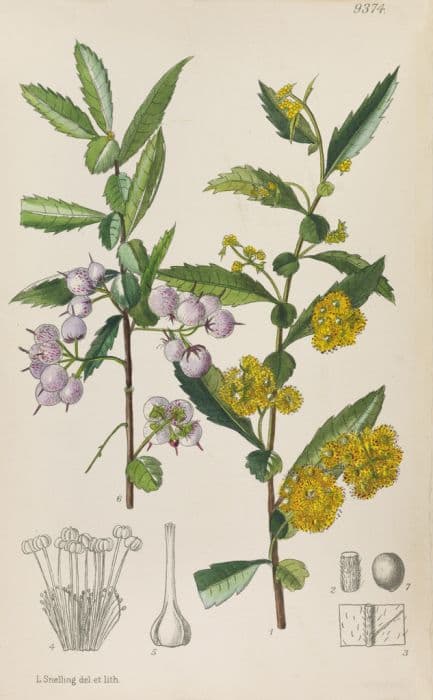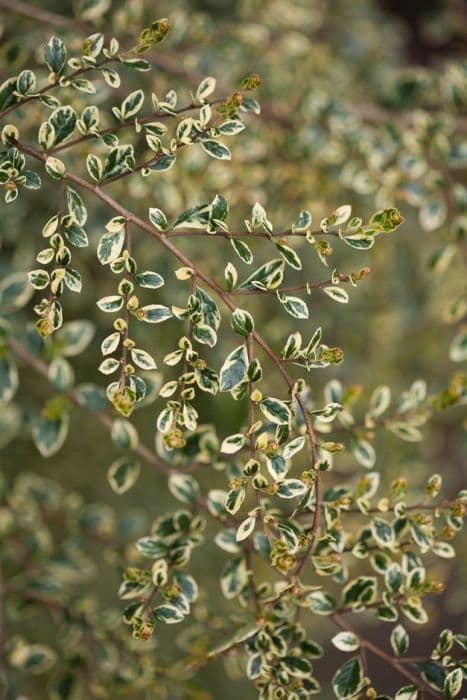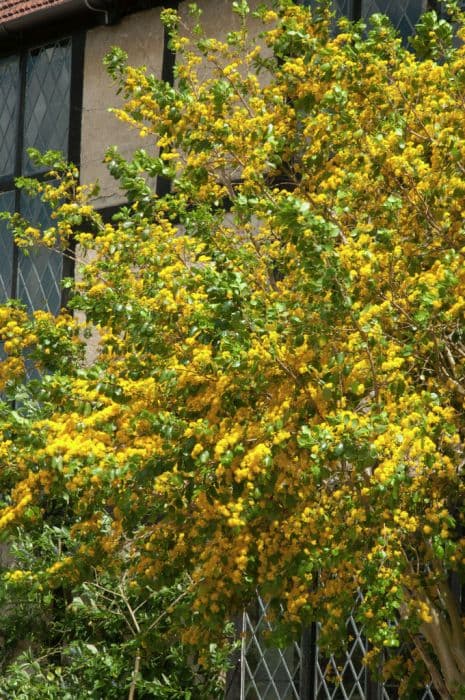Violet Willow Salix daphnoides 'Aglaia' (m)

ABOUT
The plant being described is commonly known as the violet willow. This particular variety, 'Aglaia,' is noted for its striking appearance. Its most distinctive feature stems from its colorful winter twigs, which exhibit a deep violet or purplish hue. These vibrant twigs provide a strong visual contrast, especially against snowy landscapes, making the plant a popular choice for winter interest in gardens. During spring, the violet willow produces slender catkins that are silvery at first, gradually turning yellow as the pollen emerges. These catkins add a soft textural element, contrasting the stark twigs from the winter. As the seasons change, the leaves begin to sprout, showcasing a bluish-green color. The foliage offers an elongated shape with fine serrations along the edges, providing an elegant, somewhat narrow aspect. The bark of the violet willow is another feature worth noting. It is smooth, with a glossy sheen that complements the overall aesthetic of the plant. Within the bark's texture, one may observe subtle lines and ridges that add depth and character. Overall, the violet willow 'Aglaia' variant brings with it a palette of purples, blues, and yellows throughout the year, making it a compelling choice for those looking to add year-round color and variety to their outdoor spaces, without considering its scale or the space it occupies.
About this plant
 Names
NamesFamily
Salicaceae
Synonyms
Violet Willow, Daphne Willow
Common names
Salix daphnoides 'Aglaia'.
 Toxicity
ToxicityTo humans
Violet willow is not typically known for being toxic to humans. However, it's important to note that although not considered poisonous, many plants can cause allergic reactions or be irritating if handled improperly or ingested. As with any plant, it is advisable to avoid ingesting parts of plants that are not commonly recognized as food, as they could cause upset stomach or more serious issues depending on the individual’s sensitivity and the quantity ingested.
To pets
Violet willow is not known to be toxic to pets. However, as with humans, it is generally wise to prevent pets from ingesting non-food plants since they could potentially cause digestive upset or an allergic reaction in sensitive individuals. It is always recommended to keep an eye on pets and train them not to chew on any household plants. If any unusual symptoms are noticed after ingestion, it is best to consult a veterinarian.
 Characteristics
CharacteristicsLife cycle
Perennials
Foliage type
Deciduous
Color of leaves
Green
Height
13 feet (4 meters)
Spread
10 feet (3 meters)
Plant type
Tree
Hardiness zones
4
Native area
Europe
Benefits
 General Benefits
General Benefits- Winter Interest: Salix daphnoides 'Aglaia', commonly known as Violet Willow, has vivid violet stems that add striking color to the winter landscape.
- Erosion Control: This willow is effective at stabilizing soil and preventing erosion, especially along riverbanks and slopes.
- Wildlife Habitat: It provides shelter and nesting sites for birds, and its catkins are a food source for bees and other insects in early spring.
- Ornamental Value: With its attractive stem color, catkins, and foliage, the Violet Willow is a beautiful addition to ornamental gardens.
- Rapid Growth: Violet Willow is known for its fast growth rate, quickly establishing itself in suitable environments.
- Stream and Riverbank Planting: It is often used for planting alongside waterways for both aesthetic value and practical benefits, such as soil stabilization.
- Bioenergy Crop: Because of its fast growth and regeneration ability, Salix daphnoides 'Aglaia' can be used as a bioenergy crop for biomass production.
- Shade and Shelter: Provides shade and shelter in landscapes due to its medium to large size when fully grown.
- Riparian Restoration: Suitable for riparian restoration projects to improve the stability and ecological function of waterways.
- Living Structures: Young branches are pliable and can be woven to create living sculptures, fences, and arbors, adding a unique creative element to gardens.
 Medical Properties
Medical Properties- Anti-inflammatory: Compounds in Salix daphnoides, like salicin, can be converted into salicylic acid in the body, which may help reduce inflammation.
- Analgesic: It may possess pain-relieving properties akin to those of aspirin due to its salicylic acid derivatives.
- Antipyretic: The plant can potentially be used to reduce fever, which is a common use of salicylic acid derivatives.
- Astringent: The tannins present in the bark might have astringent qualities, potentially useful for skin conditions and as a topical treatment.
 Air-purifying Qualities
Air-purifying QualitiesThis plant is not specifically known for air purifying qualities.
 Other Uses
Other Uses- Willow bark extract from Salix daphnoides, commonly referred to as Violet Willow, can be used as a natural rooting hormone to stimulate the growth of plant cuttings.
- Violet Willow's flexible branches may be used in basketry, providing material for weavers to create various woven goods.
- The wood of the Violet Willow is useful in the production of high-quality charcoal, often used by artists for drawing.
- Young shoots of the Violet Willow can be woven into living structures such as tunnels, arbors, and fences in a practice known as willow sculpting.
- The inner bark of Violet Willow can be processed into a fiber for making paper, offering an alternative to traditional wood pulp paper.
- During winter, the colorful stems of Violet Willow can be used in decorative floral arrangements to add contrast and visual interest.
- Violet Willow can serve as a food source for livestock, particularly in times of fodder scarcity, although care should be taken regarding the salicylic acid content.
- The smooth and slender branches of the Violet Willow are sometimes employed in the crafting of small musical instruments or parts, such as flutes or whistles.
- Violet Willow can contribute to soil erosion control efforts, as its extensive root system stabilizes riverbanks and other erosion-prone areas.
- The plant may be utilized in phytoremediation projects to clean up soil contaminated with heavy metals, thanks to its tolerance and accumulation capabilities.
Interesting Facts
 Feng Shui
Feng ShuiThe Violet Willow is not used in Feng Shui practice.
 Zodiac Sign Compitability
Zodiac Sign CompitabilityThe Violet Willow is not used in astrology practice.
 Plant Symbolism
Plant Symbolism- Flexibility: The willow, which Salix daphnoides 'Aglaia' belongs to, is known for its ability to bend without breaking. This symbolizes adaptability and resilience in the face of challenges.
- Growth and Vitality: Willows are fast-growing trees, which makes them a symbol of rapid growth and the unstoppable force of life.
- Healing: Traditionally, willow bark has been used for its medicinal properties, thus the tree can represent healing and the alleviation of pain.
- Sorrow: The weeping form of some willows has led to their association with sorrow, mourning, and the expression of deep emotions.
- Inspiration: Because of its association with water and the moon, willows are often related to inspiration, poetry, and the creative muses.
 Water
WaterViolet willow should be watered regularly, especially during the first few growing seasons to establish a deep and extensive root system. Watering should be deep and thorough, ensuring the soil is moist but not waterlogged. During dry spells, water every week, providing about 15 to 20 gallons per session for mature trees. In periods of regular rainfall, water may only be necessary every two to three weeks. Adjust the frequency based on temperature and soil conditions, watering more often in hot, dry weather and less during cooler, moist periods.
 Light
LightViolet willow thrives best in full sun to partial shade. It should be planted in a location where it can receive at least six hours of direct sunlight daily. These trees are adaptable, but they perform optimally when they have ample sunlight, which promotes vigorous growth and healthy foliage.
 Temperature
TemperatureViolet willow is hardy and can tolerate a wide range of temperatures; it can survive in temperatures as low as -20°F and as high as 120°F. However, the ideal temperature range for thriving growth is between 50°F and 75°F. Avoid planting in areas where temperatures drop below the minimum range for extended periods to prevent cold damage.
 Pruning
PruningViolet willow should be pruned to maintain its shape and to remove any damaged or diseased branches. Pruning is best performed in late winter or early spring before new growth starts. It is often enough to prune once a year, focusing on shaping the tree and promoting healthy growth. The removal of suckers and any branches that cross over or rub against each other is also recommended.
 Cleaning
CleaningAs needed
 Soil
SoilThe best soil mix for the Violet Willow (Salix daphnoides 'Aglaia') should be well-draining, with a mixture of sandy loam and peat for moisture retention. The soil pH should be slightly acidic to neutral, ranging from 6.0 to 7.0.
 Repotting
RepottingViolet Willow generally does not require frequent repotting and prefers to be left undisturbed. Plant it in a large enough space outdoors where it can grow without the need for repotting. If grown in a container, repot every few years.
 Humidity & Misting
Humidity & MistingViolet Willow thrives in moderate to high humidity levels but is adaptable to various atmospheric conditions. However, it does best with humidity levels between 40% to 70%.
 Suitable locations
Suitable locationsIndoor
Provide bright light, cool conditions, and water generously.
Outdoor
Plant in full sun to partial shade, well-draining soil.
Hardiness zone
4-9 USDA
 Life cycle
Life cycleThe common name for Salix daphnoides 'Aglaia' is Violet Willow. The life cycle of the Violet Willow begins with seed germination, which occurs in moist soil conditions in early spring. After germination, the seedling grows rapidly and develops a root system and shoots; this juvenile phase can last for a few years. The plant then progresses to the mature phase, characterized by the production of flowering catkins, which pollinated by insects or wind lead to seed set. Violet Willow reaches sexual maturity in a few years and can start reproducing typically within 4-5 years. Following reproduction, the tree can live for several decades, with some individuals reaching up to a century, during which time it will repeatedly produce seeds, contributing to the next generation before eventually senescing and dying.
 Propogation
PropogationPropogation time
Late winter
Salix daphnoides 'Aglaia', commonly known as violet willow, is most commonly propagated using softwood cuttings. This method is generally performed in late spring or early summer when the plant's new growth is still green and flexible. To propagate, a cutting of about 6 to 8 inches (15 to 20 centimeters) in length is taken from a healthy branch, with the lower leaves removed and the cut end dipped in rooting hormone for better establishment. The cutting is then inserted into a well-draining soil mix, ensuring that several nodes where leaves were attached are buried as these are the areas where roots are most likely to form. The soil should be kept moist but not waterlogged, and the cutting should be placed in indirect light until it has established a good root system, which can be checked by gently tugging on the cutting to feel for resistance.









